Cyclic Deformation Behavior of Additive-Manufactured IN738LC Superalloys from Virgin and Reused Powders
Abstract
:1. Introduction
2. Materials and Experimental Procedures
2.1. Materials
2.2. Mechanical Tests
2.3. Microstructure Characterization
3. Results
3.1. Powder Characterization
3.2. Original Microstructure
3.3. Monotonic Tensile Properties
3.4. Fatigue Behavior
3.5. Fatigue Fracture
4. Discussion
4.1. Powder Properties
4.2. Fatigue Cracking
5. Conclusions
Author Contributions
Funding
Institutional Review Board Statement
Informed Consent Statement
Data Availability Statement
Acknowledgments
Conflicts of Interest
References
- Pollock, T.M.; Tin, S. Nickel-Based Superalloys for Advanced Turbine Engines: Chemistry, Microstructure and Properties. J. Propuls. Power 2006, 22, 361–374. [Google Scholar] [CrossRef]
- Panwisawas, C.; Tang, Y.T.; Reed, R.C. Metal 3D Printing as a Disruptive Technology for Superalloys. Nat. Commun. 2020, 11, 2327. [Google Scholar] [CrossRef]
- DebRoy, T.; Wei, H.L.; Zuback, J.S.; Mukherjee, T.; Elmer, J.W.; Milewski, J.O.; Beese, A.M.; Wilson-Heid, A.; De, A.; Zhang, W. Additive Manufacturing of Metallic Components—Process, Structure and Properties. Prog. Mater. Sci. 2018, 92, 112–224. [Google Scholar] [CrossRef]
- Sing, S.L.; An, J.; Yeong, W.Y.; Wiria, F.E. Laser and Electron-Beam Powder-Bed Additive Manufacturing of Metallic Implants: A Review on Processes, Materials and Designs. J. Orthop. Res. 2016, 34, 369–385. [Google Scholar] [CrossRef]
- Matthews, M.J.; Guss, G.; Khairallah, S.A.; Rubenchik, A.M.; Depond, P.J.; King, W.E. Denudation of Metal Powder Layers in Laser Powder Bed Fusion Processes. Acta Mater. 2016, 114, 33–42. [Google Scholar] [CrossRef] [Green Version]
- Zapico, P.; Giganto, S.; Barreiro, J.; Martínez-Pellitero, S. Characterisation of 17-4PH Metallic Powder Recycling to Optimise the Performance of the Selective Laser Melting Process. J. Mater. Res. Technol. 2020, 9, 1273–1285. [Google Scholar] [CrossRef]
- Nandwana, P.; Peter, W.H.; Dehoff, R.R.; Lowe, L.E.; Kirka, M.M.; Medina, F.; Babu, S.S. Recyclability Study on Inconel 718 and Ti-6Al-4V Powders for Use in Electron Beam Melting. Metall. Mater. Trans. B Process Metall. Mater. Process. Sci. 2016, 47, 754–762. [Google Scholar] [CrossRef]
- Tang, H.P.; Qian, M.; Liu, N.; Zhang, X.Z.; Yang, G.Y.; Wang, J. Effect of Powder Reuse Times on Additive Manufacturing of Ti-6Al-4V by Selective Electron Beam Melting. JOM 2015, 67, 555–563. [Google Scholar] [CrossRef]
- Gruber, H.; Henriksson, M.; Hryha, E.; Nyborg, L. Effect of Powder Recycling in Electron Beam Melting on the Surface Chemistry of Alloy 718 Powder. Metall. Mater. Trans. A Phys. Metall. Mater. Sci. 2019, 50, 4410–4422. [Google Scholar] [CrossRef] [Green Version]
- Gruber, H.; Luchian, C.; Hryha, E.; Nyborg, L. Effect of Powder Recycling on Defect Formation in Electron Beam Melted Alloy 718. Metall. Mater. Trans. A 2020, 51, 2430–2443. [Google Scholar] [CrossRef]
- Santecchia, E.; Spigarelli, S.; Cabibbo, M. Material Reuse in Laser Powder Bed Fusion: Side Effects of the Laser—Metal Powder Interaction. Metals 2020, 10, 341. [Google Scholar] [CrossRef] [Green Version]
- Lutter-Günther, M.; Gebbe, C.; Kamps, T.; Seidel, C.; Reinhart, G. Powder Recycling in Laser Beam Melting: Strategies, Consumption Modeling and Influence on Resource Efficiency. Prod. Eng. 2018, 12, 377–389. [Google Scholar] [CrossRef]
- Fiegl, T.; Franke, M.; Raza, A.; Hryha, E.; Körner, C. Effect of AlSi10Mg0.4 Long-Term Reused Powder in PBF-LB/M on the Mechanical Properties. Mater. Des. 2021, 212, 110176. [Google Scholar] [CrossRef]
- Renderos, M.; Torregaray, A.; Gutierrez-Orrantia, M.E.; Lamikiz, A.; Saintier, N.; Girot, F. Microstructure Characterization of Recycled IN718 Powder and Resulting Laser Clad Material. Mater. Charact. 2017, 134, 103–113. [Google Scholar] [CrossRef] [Green Version]
- Paccou, E.; Mokhtari, M.; Keller, C.; Nguejio, J.; Lefebvre, W.; Sauvage, X.; Boileau, S.; Babillot, P.; Bernard, P.; Bauster, E. Investigations of Powder Reusing on Microstructure and Mechanical Properties of Inconel 718 Obtained by Additive Manufacturing. Mater. Sci. Eng. A 2021, 828, 142113. [Google Scholar] [CrossRef]
- Carrion, P.E.; Soltani-Tehrani, A.; Phan, N.; Shamsaei, N. Powder Recycling Effects on the Tensile and Fatigue Behavior of Additively Manufactured Ti-6Al-4V Parts. JOM 2019, 71, 963–973. [Google Scholar] [CrossRef] [Green Version]
- Soltani-Tehrani, A.; Pegues, J.; Shamsaei, N. Fatigue Behavior of Additively Manufactured 17-4 PH Stainless Steel: The Effects of Part Location and Powder Re-Use. Addit. Manuf. 2020, 36, 101398. [Google Scholar] [CrossRef]
- Xu, J.; Gruber, H.; Boyd, R.; Jiang, S.; Peng, R.L.; Moverare, J.J. On the Strengthening and Embrittlement Mechanisms of an Additively Manufactured Nickel-Base Superalloy. Materialia 2020, 10, 100657. [Google Scholar] [CrossRef]
- Kunze, K.; Etter, T.; Grässlin, J.; Shklover, V. Texture, Anisotropy in Microstructure and Mechanical Properties of IN738LC Alloy Processed by Selective Laser Melting (SLM). Mater. Sci. Eng. A 2015, 620, 213–222. [Google Scholar] [CrossRef]
- Geiger, F.; Kunze, K.; Etter, T. Tailoring the Texture of IN738LC Processed by Selective Laser Melting (SLM) by Specific Scanning Strategies. Mater. Sci. Eng. A 2016, 661, 240–246. [Google Scholar] [CrossRef]
- Xu, J.; Gruber, H.; Deng, D.; Peng, R.L.; Moverare, J.J. Short-Term Creep Behavior of an Additive Manufactured Non-Weldable Nickel-Base Superalloy Evaluated by Slow Strain Rate Testing. Acta Mater. 2019, 179, 142–157. [Google Scholar] [CrossRef]
- Hu, Y.; Kang, W.; Zhang, H.; Chu, C.; Wang, L.; Hu, Y.; Ding, Y.; Zhang, D. Hot Corrosion Behavior of IN738LC Alloy Formed by Selective Laser Melting. Corros. Sci. 2022, 198, 110154. [Google Scholar] [CrossRef]
- Gruber, H. Electron Beam Melting of Alloy 718 Powder Recycling and Its Effect on Defect Formation; Chalmers Tekniska Hogskola: Hogskola, Sweden, 2019. [Google Scholar]
- ASTM E466-15 (2015); Standard Practice for Conducting Force Controlled Constant Amplitude Axial Fatigue Tests of Metallic Materials. ASTM International: West Conshohocken, PA, USA, 2015.
- Bachmann, F.; Hielscher, R.; Schaeben, H. Grain Detection from 2d and 3d EBSD Data-Specification of the MTEX Algorithm. Ultramicroscopy 2011, 111, 1720–1733. [Google Scholar] [CrossRef]
- Hryha, E.; Riabov, D. Metal Powder Production for Additive Manufacturing. Encycl. Mater. Met. Alloy. 2022, 1, 264–271. [Google Scholar] [CrossRef]
- Pauzon, C.; Raza, A.; Hryha, E.; Forêt, P. Oxygen Balance during Laser Powder Bed Fusion of Alloy 718. Mater. Des. 2021, 201, 109511. [Google Scholar] [CrossRef]
- Raza, A.; Pauzon, C.; Hryha, E.; Markström, A.; Forêt, P. Spatter Oxidation during Laser Powder Bed Fusion of Alloy 718: Dependence on Oxygen Content in the Process Atmosphere. Addit. Manuf. 2021, 48, 102369. [Google Scholar] [CrossRef]
- Pauzon, C.; Dietrich, K.; Forêt, P.; Hryha, E.; Witt, G. Mitigating Oxygen Pick-up during Laser Powder Bed Fusion of Ti-6Al-4V by Limiting Heat Accumulation. Mater. Lett. 2021, 288, 129365. [Google Scholar] [CrossRef]
- Schijve, J. Fatigue of Structures and Materials; Springer: Dordrecht, The Netherlands, 2001. [Google Scholar]
- Przybyla, C.P.; McDowell, D.L. Microstructure-Sensitive Extreme Value Probabilities for High Cycle Fatigue of Ni-Base Superalloy IN100. Int. J. Plast. 2010, 26, 372–394. [Google Scholar] [CrossRef]
- Zhu, M.L.; Jin, L.; Xuan, F.Z. Fatigue Life and Mechanistic Modeling of Interior Micro-Defect Induced Cracking in High Cycle and Very High Cycle Regimes. Acta Mater. 2018, 157, 259–275. [Google Scholar] [CrossRef]
- Chan, K.S. Roles of Microstructure in Fatigue Crack Initiation. Int. J. Fatigue 2010, 32, 1428–1447. [Google Scholar] [CrossRef]
- Shao, C.; Lu, F.; Wang, X.; Ding, Y.; Li, Z. Microstructure Characterization and HCF Fracture Mode Transition for Modified 9Cr-1Mo Dissimilarly Welded Joint at Different Elevated Temperatures. J. Mater. Sci. Technol. 2017, 33, 1610–1620. [Google Scholar] [CrossRef]
- Yang, K.; Huang, Q.; Wang, Q.; Chen, Q. Competing Crack Initiation Behaviors of a Laser Additively Manufactured Nickel-Based Superalloy in High and Very High Cycle Fatigue Regimes. Int. J. Fatigue 2020, 136, 105580. [Google Scholar] [CrossRef]
- Pang, H.T.; Reed, P.A.S. Fatigue Crack Initiation and Short Crack Growth in Nickel-Base Turbine Disc Alloys—The Effects of Microstructure and Operating Parameters. Int. J. Fatigue 2003, 25, 1089–1099. [Google Scholar] [CrossRef]
- Prithivirajan, V.; Sangid, M.D. The Role of Defects and Critical Pore Size Analysis in the Fatigue Response of Additively Manufactured IN718 via Crystal Plasticity. Mater. Des. 2018, 150, 139–153. [Google Scholar] [CrossRef]
- Prithivirajan, V.; Ravi, P.; Naragani, D.; Sangid, M.D. Direct Comparison of Microstructure-Sensitive Fatigue Crack Initiation via Crystal Plasticity Simulations and in Situ High-Energy X-ray Experiments. Mater. Des. 2021, 197, 109216. [Google Scholar] [CrossRef]
- Raza, A.; Fiegl, T.; Hanif, I.; MarkstrÖm, A.; Franke, M.; Körner, C.; Hryha, E. Degradation of AlSi10Mg Powder during Laser Based Powder Bed Fusion Processing. Mater. Des. 2021, 198, 109358. [Google Scholar] [CrossRef]
- Pauzon, C.; Markström, A.; Goff, S.D.-L.; Hryha, E. Effect of the Process Atmosphere Composition on Alloy 718 Produced by Laser Powder Bed Fusion. Metals 2021, 11, 1254. [Google Scholar] [CrossRef]
- Cordova, L.; Campos, M.; Tinga, T. Revealing the Effects of Powder Reuse for Selective Laser Melting by Powder Characterization. JOM 2019, 71, 1062–1072. [Google Scholar] [CrossRef] [Green Version]
- Powell, D.; Rennie, A.E.W.; Geekie, L.; Burns, N. Understanding Powder Degradation in Metal Additive Manufacturing to Allow the Upcycling of Recycled Powders. J. Clean. Prod. 2020, 268, 122077. [Google Scholar] [CrossRef]
- Ardila, L.C.; Garciandia, F.; González-Díaz, J.B.; Álvarez, P.; Echeverria, A.; Petite, M.M.; Deffley, R.; Ochoa, J. Effect of IN718 Recycled Powder Reuse on Properties of Parts Manufactured by Means of Selective Laser Melting. Phys. Procedia 2014, 56, 99–107. [Google Scholar] [CrossRef]
- Feng, S.; Chen, S.; Kamat, A.M.; Zhang, R.; Huang, M.; Hu, L. Investigation on Shape Deviation of Horizontal Interior Circular Channels Fabricated by Laser Powder Bed Fusion. Addit. Manuf. 2020, 36, 101585. [Google Scholar] [CrossRef]
- Zhao, Y.; Aoyagi, K.; Daino, Y.; Yamanaka, K.; Chiba, A. Significance of Powder Feedstock Characteristics in Defect Suppression of Additively Manufactured Inconel 718. Addit. Manuf. 2020, 34, 101277. [Google Scholar] [CrossRef]
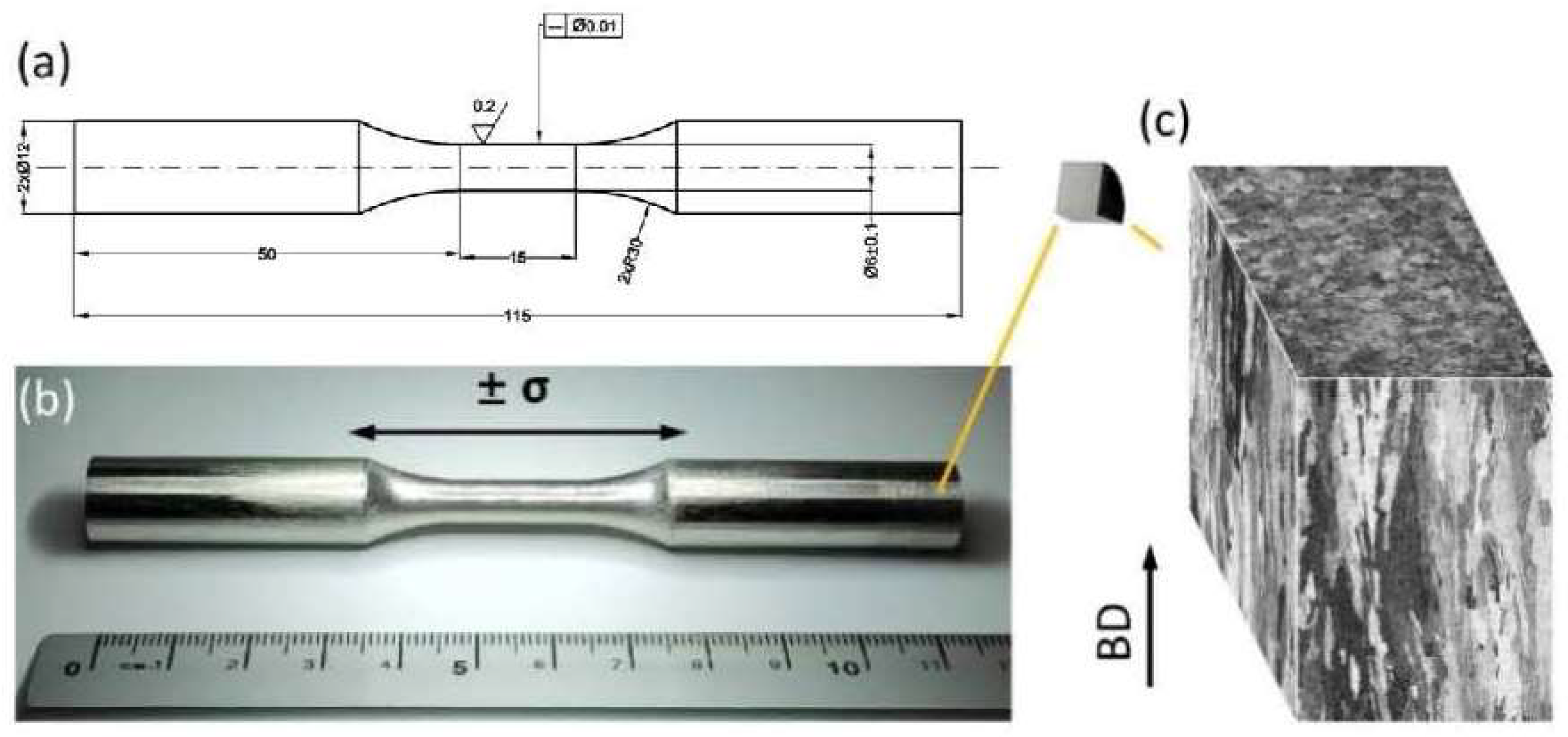
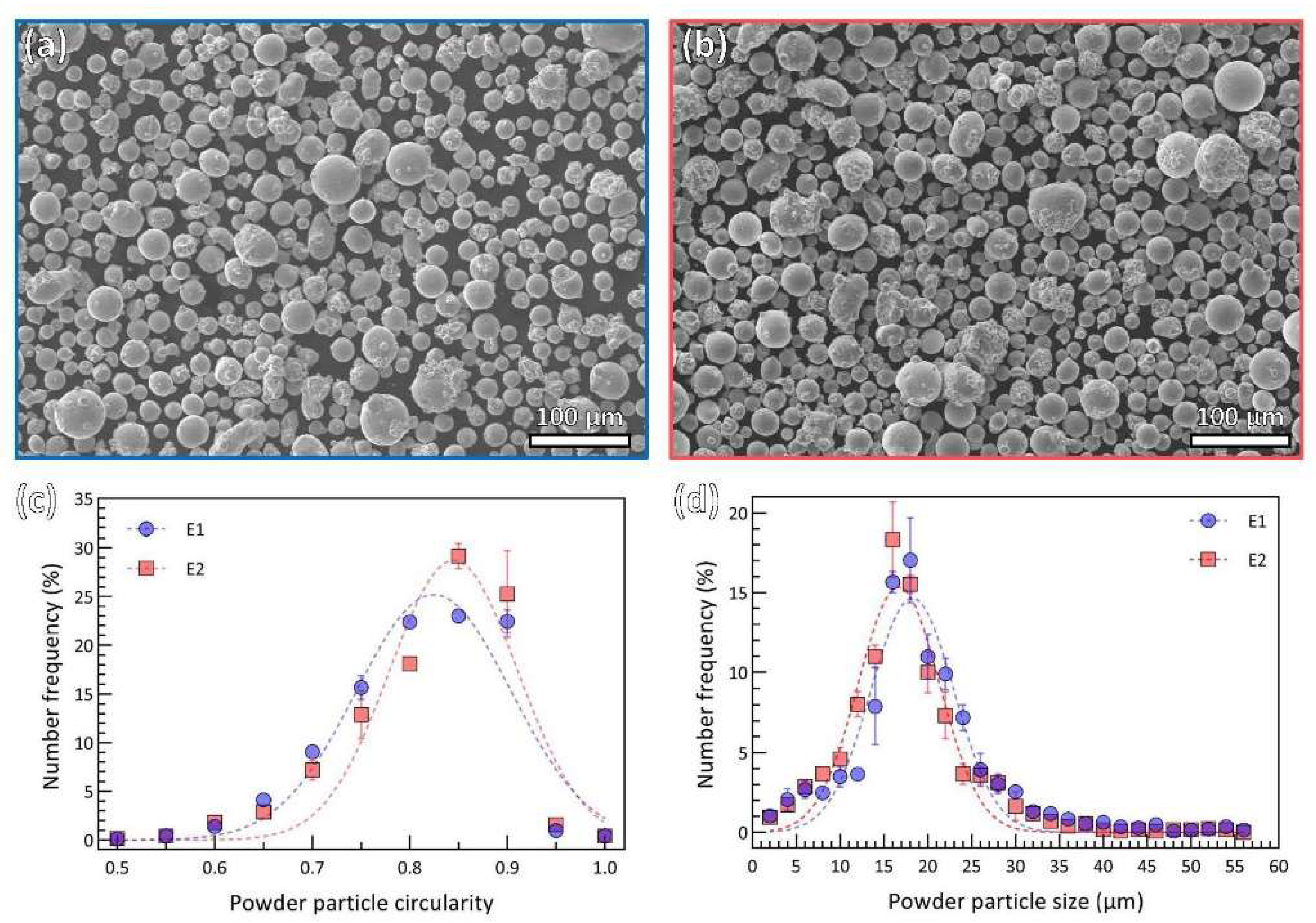
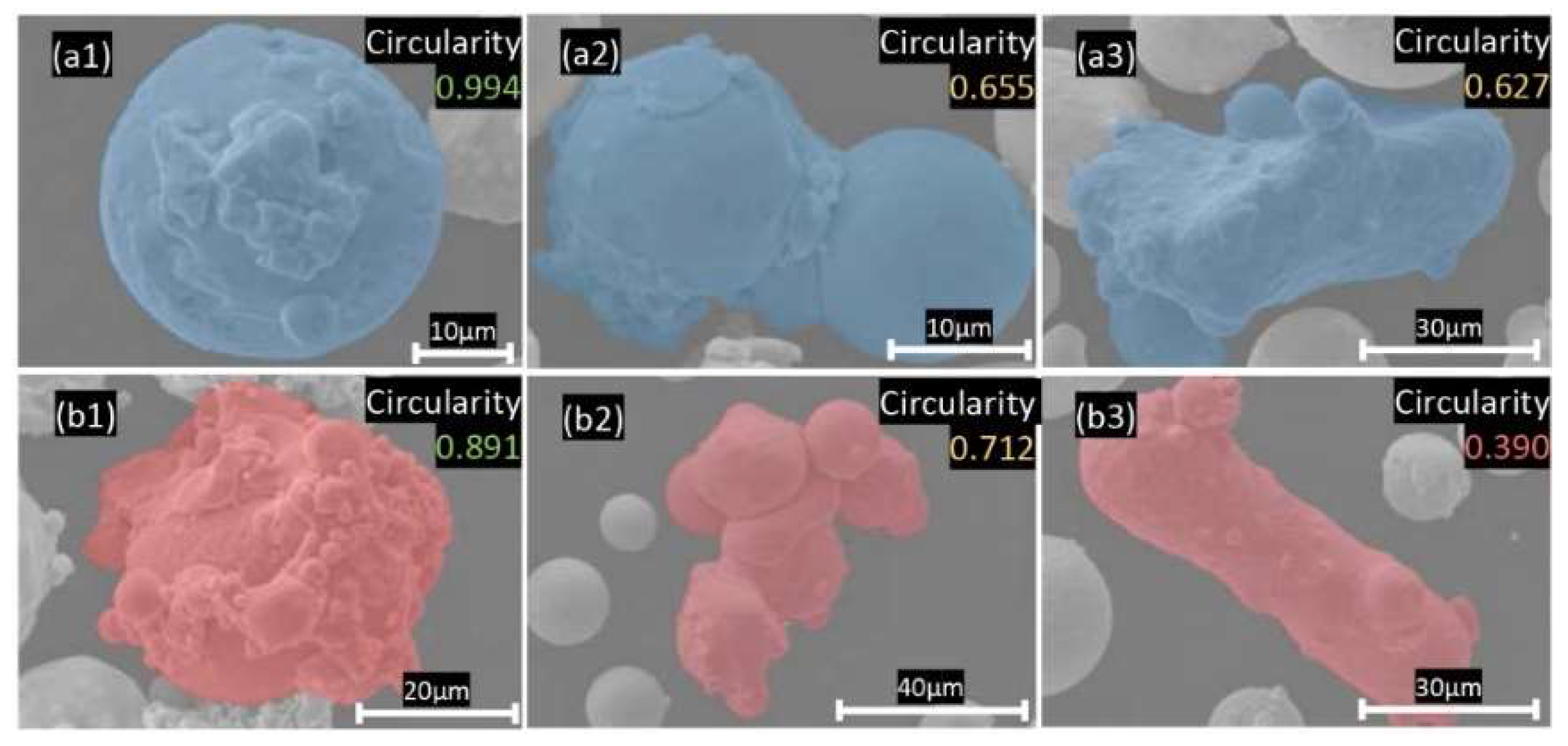
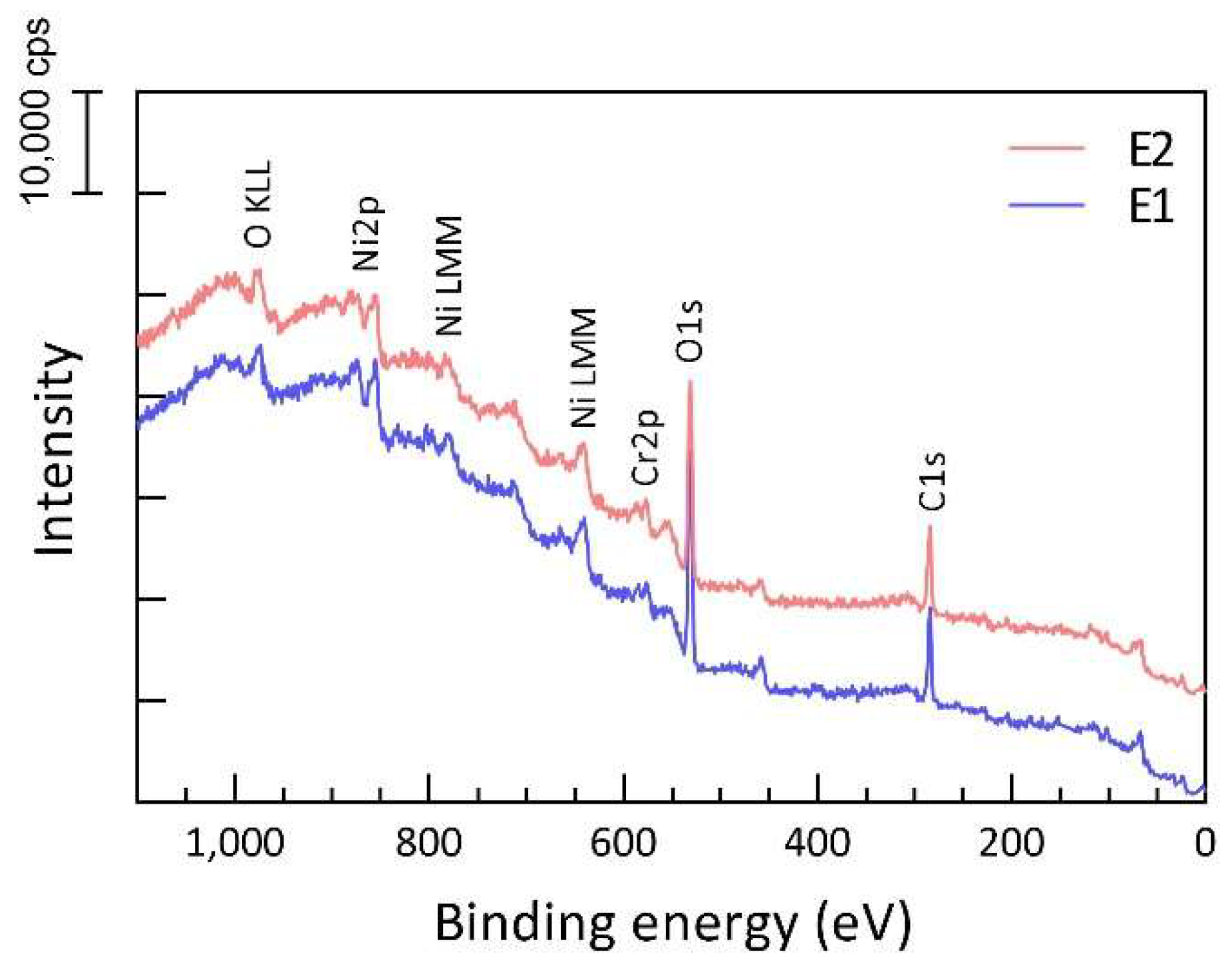

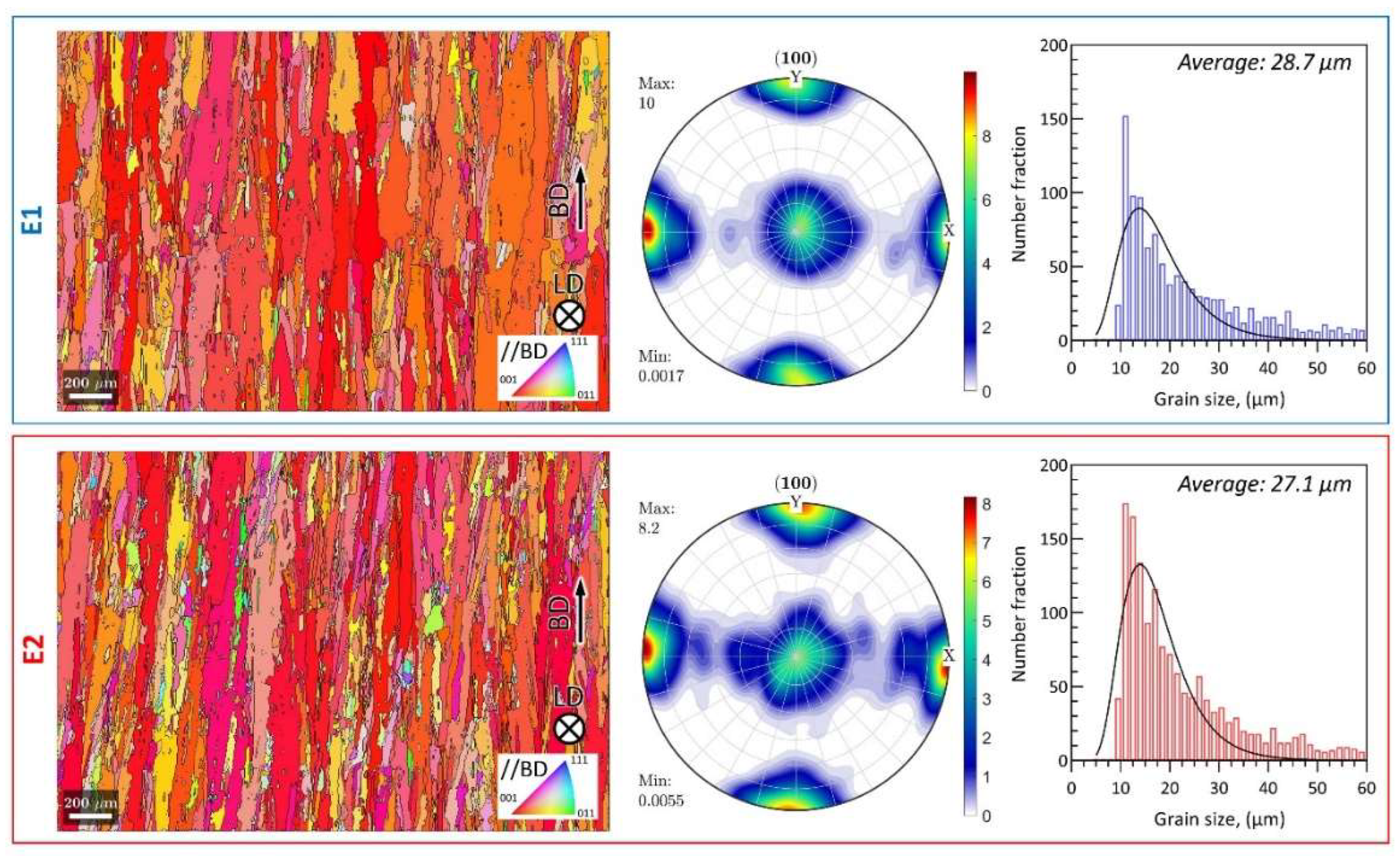


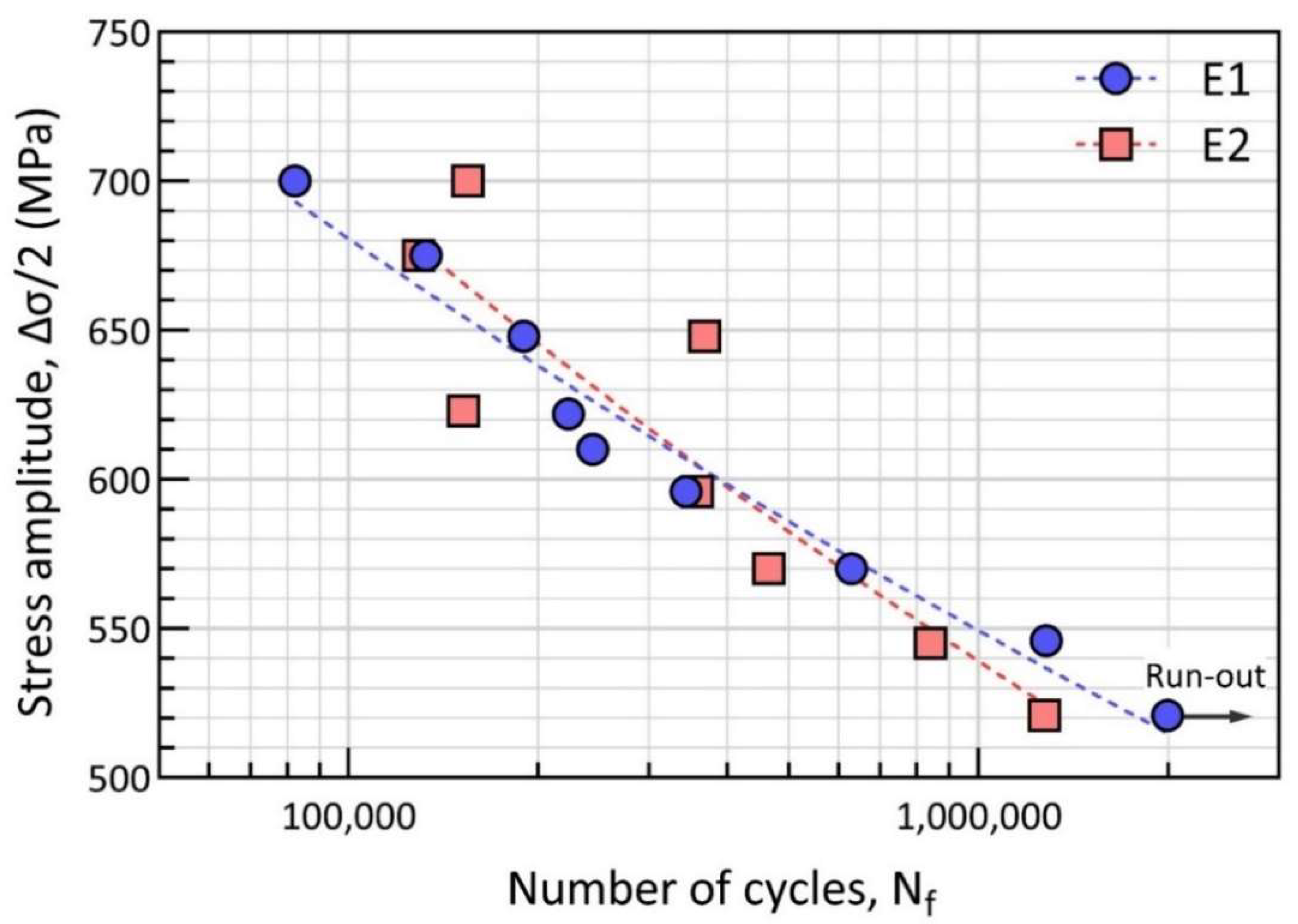
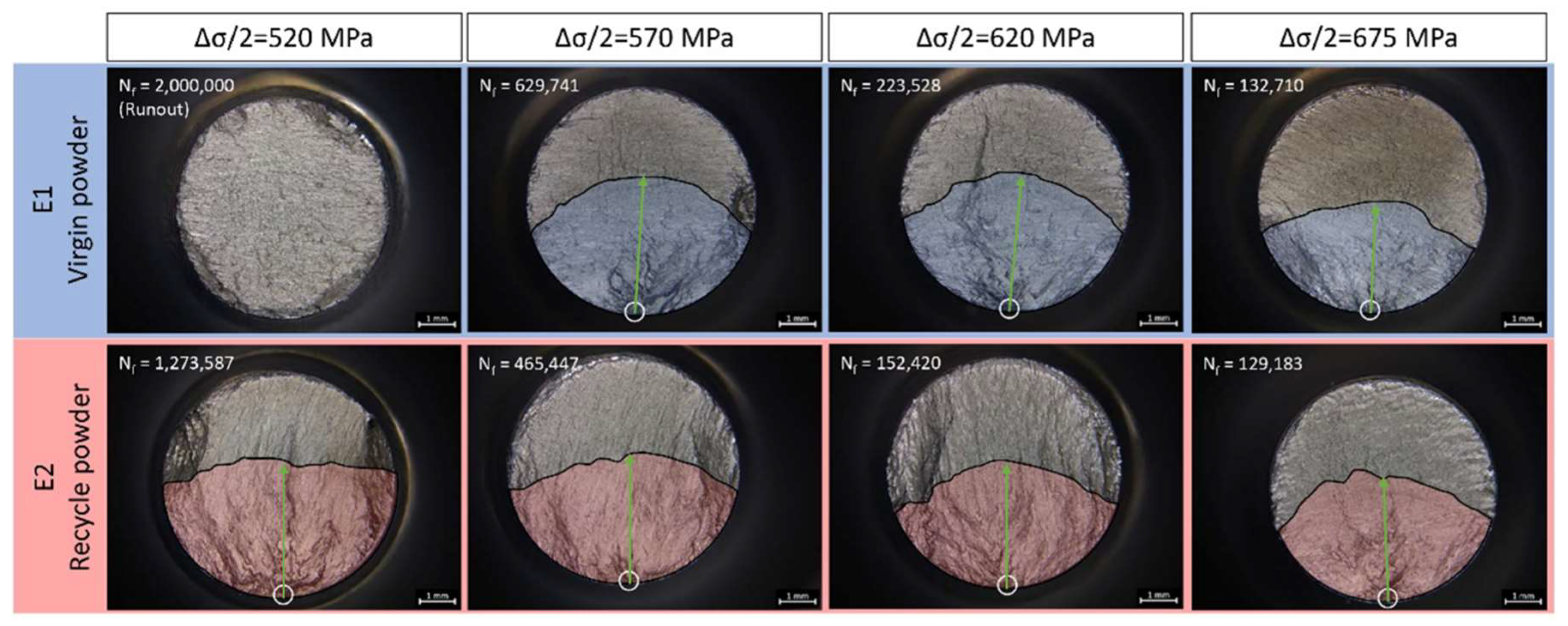
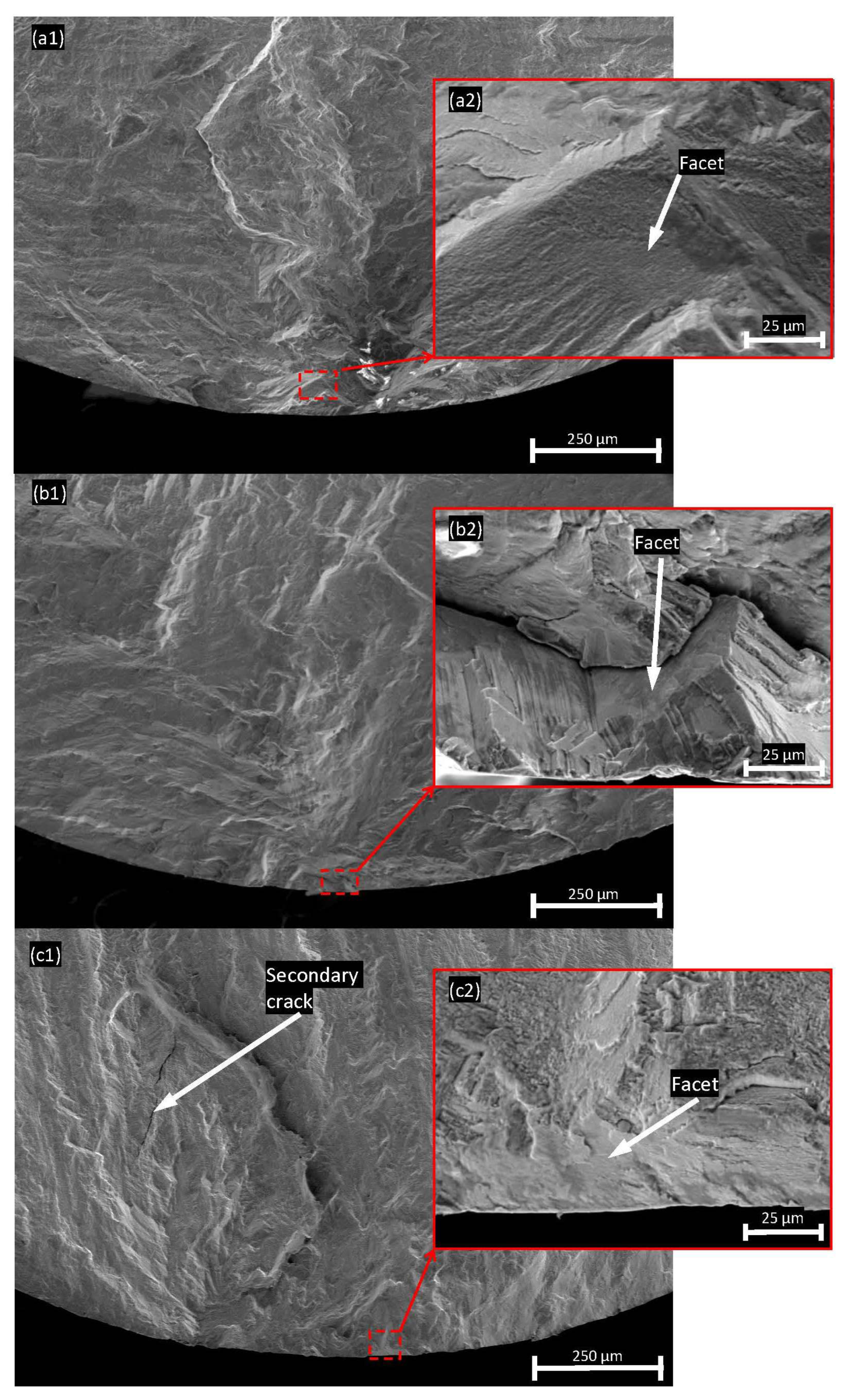

| Laser Power (W) | Scanning Speed (mm/s) | Hatch Distance (µm) | Layer Thickness (µm) |
|---|---|---|---|
| 210 | 1750 | 50 | 20 |
| Element | Ni | Cr | Co | Ti | Al | W | Mo | Ta | Nb |
|---|---|---|---|---|---|---|---|---|---|
| wt. % | Bal. | 17.2 | 9.4 | 3.6 | 3.5 | 2.6 | 1.9 | 1.74 | 0.9 |
| Element | C | Fe | Si | Zr | B | N | S | Mn | P |
| wt. % | 0.101 | 0.07 | 0.04 | 0.03 | 0.02 | 0.00564 | 0.00376 | <0.005 | <0.001 |
| Stress Amplitude, σa (MPa) | Sample | Cycles to Failure, Nf |
|---|---|---|
| 520 | E1/E2 | 2,000,000 (Run-out)/1,273,587 |
| 545 | E1/E2 | 1,282,237/839,941 |
| 570 | E1/E2 | 629,742/465,447 |
| 595 | E1/E2 | 344,026/357,996 |
| 610 | E1 | 244,310 |
| 620 | E1/E2 | 223,528/152,410 |
| 645 | E1/E2 | 189,903/368,200 |
| 675 | E1/E2 | 132,710/129,183 |
| 700 | E1/E2 | 82,223/154,741 |
| Fatigue Strength Coefficient, (MPa) | Fatigue Strength Exponent, | |
|---|---|---|
| E1 | 2065 | −0.091 |
| E2 | 2776 | −0.113 |
Publisher’s Note: MDPI stays neutral with regard to jurisdictional claims in published maps and institutional affiliations. |
© 2022 by the authors. Licensee MDPI, Basel, Switzerland. This article is an open access article distributed under the terms and conditions of the Creative Commons Attribution (CC BY) license (https://creativecommons.org/licenses/by/4.0/).
Share and Cite
Chen, J.; Xu, J.; Segersäll, M.; Hryha, E.; Peng, R.L.; Moverare, J. Cyclic Deformation Behavior of Additive-Manufactured IN738LC Superalloys from Virgin and Reused Powders. Materials 2022, 15, 8925. https://doi.org/10.3390/ma15248925
Chen J, Xu J, Segersäll M, Hryha E, Peng RL, Moverare J. Cyclic Deformation Behavior of Additive-Manufactured IN738LC Superalloys from Virgin and Reused Powders. Materials. 2022; 15(24):8925. https://doi.org/10.3390/ma15248925
Chicago/Turabian StyleChen, Jialiang, Jinghao Xu, Mikael Segersäll, Eduard Hryha, Ru Lin Peng, and Johan Moverare. 2022. "Cyclic Deformation Behavior of Additive-Manufactured IN738LC Superalloys from Virgin and Reused Powders" Materials 15, no. 24: 8925. https://doi.org/10.3390/ma15248925









